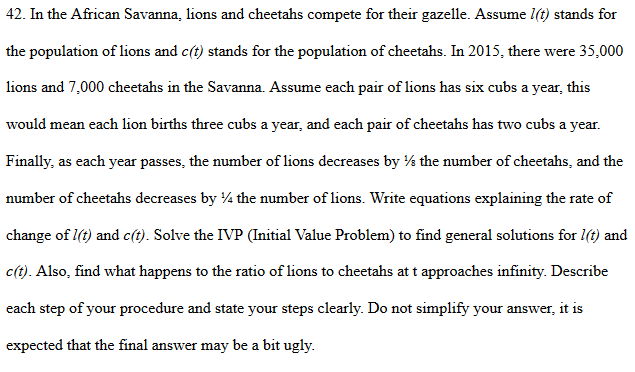42. In the African Savanna, lions and cheetahs compete for their gazelle. Assume l(t) stands for the population of lions and c(t) stands for the population of cheetahs. In 2015, there were 35,000 lions and 7,000 cheetahs in the Savanna. Assume each pair of lions has six cubs a year, this would mean each lion births three cubs a year, and each pair of cheetahs has two cubs a year. Finally, as each year passes, the number of lions decreases by ½ the number of cheetahs, and the number of cheetahs decreases by ¼ the number of lions. Write equations explaining the rate of change of l(t) and c(t). Solve the IVP (Initial Value Problem) to find general solutions for 1(t) and c(t). Also, find what happens to the ratio of lions to cheetahs at t approaches infinity. Describe each step of your procedure and state your steps clearly. Do not simplify your answer, it is expected that the final answer may be a bit ugly.
42. In the African Savanna, lions and cheetahs compete for their gazelle. Assume l(t) stands for the population of lions and c(t) stands for the population of cheetahs. In 2015, there were 35,000 lions and 7,000 cheetahs in the Savanna. Assume each pair of lions has six cubs a year, this would mean each lion births three cubs a year, and each pair of cheetahs has two cubs a year. Finally, as each year passes, the number of lions decreases by ½ the number of cheetahs, and the number of cheetahs decreases by ¼ the number of lions. Write equations explaining the rate of change of l(t) and c(t). Solve the IVP (Initial Value Problem) to find general solutions for 1(t) and c(t). Also, find what happens to the ratio of lions to cheetahs at t approaches infinity. Describe each step of your procedure and state your steps clearly. Do not simplify your answer, it is expected that the final answer may be a bit ugly.
Linear Algebra: A Modern Introduction
4th Edition
ISBN:9781285463247
Author:David Poole
Publisher:David Poole
Chapter2: Systems Of Linear Equations
Section2.4: Applications
Problem 28EQ
Related questions
Topic Video
Question

Transcribed Image Text:42. In the African Savanna, lions and cheetahs compete for their gazelle. Assume l(t) stands for
the population of lions and c(t) stands for the population of cheetahs. In 2015, there were 35,000
lions and 7,000 cheetahs in the Savanna. Assume each pair of lions has six cubs a year, this
would mean each lion births three cubs a year, and each pair of cheetahs has two cubs a year.
Finally, as each year passes, the number of lions decreases by ½ the number of cheetahs, and the
number of cheetahs decreases by 4 the number of lions. Write equations explaining the rate of
change of 1(t) and c(t). Solve the IVP (Initial Value Problem) to find general solutions for l(t) and
c(t). Also, find what happens to the ratio of lions to cheetahs at t approaches infinity. Describe
each step of your procedure and state your steps clearly. Do not simplify your answer, it is
expected that the final answer may be a bit ugly.
Expert Solution
This question has been solved!
Explore an expertly crafted, step-by-step solution for a thorough understanding of key concepts.
Step by step
Solved in 5 steps

Knowledge Booster
Learn more about
Need a deep-dive on the concept behind this application? Look no further. Learn more about this topic, advanced-math and related others by exploring similar questions and additional content below.Recommended textbooks for you

Linear Algebra: A Modern Introduction
Algebra
ISBN:
9781285463247
Author:
David Poole
Publisher:
Cengage Learning

College Algebra
Algebra
ISBN:
9781305115545
Author:
James Stewart, Lothar Redlin, Saleem Watson
Publisher:
Cengage Learning

Linear Algebra: A Modern Introduction
Algebra
ISBN:
9781285463247
Author:
David Poole
Publisher:
Cengage Learning

College Algebra
Algebra
ISBN:
9781305115545
Author:
James Stewart, Lothar Redlin, Saleem Watson
Publisher:
Cengage Learning